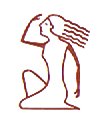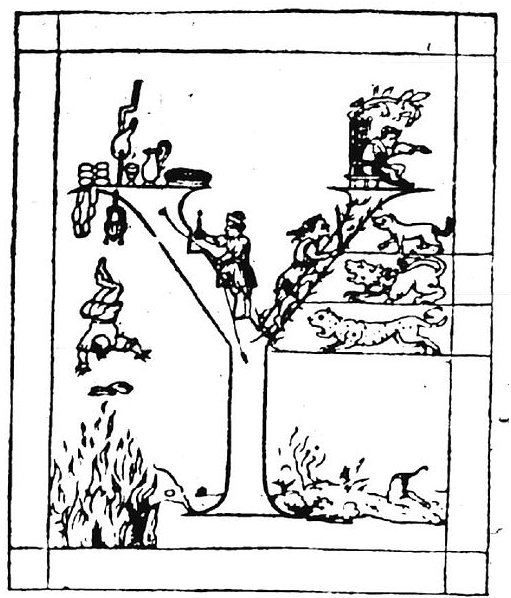Line Da1 carries 20 glyphs, whereas the surface of the larger G
tahlet has 26 glyphs in its first line, with the last 6 of them beginning with
APRIL 11 (101)
and a preceding moe glyph.

... Matua [A Taana] said to
Hotu [A Matua], 'Take along the Hanau Eepe and
let them work the land!' Hotu called out to Heke:
'Go and bring the 500 prisoners on board the canoe!' He took all
of them along, led them on board the canoe, and left them there.
For six days (po ono), mats (moenga) were taken on
board the canoe (i.e., the loading of the canoe took six days)
... [E:73-74]
But Da1-20 is not that type of glyph:

|
Dec 6 (340) |
7 |
8 |
9 |
10 (344) |
|
OCT 3 |
4 |
5 |
6 |
7 (*200, 280) |
 |
 |
 |
 |
 |
|
Da1-12 |
Da1-13 |
Da1-14 |
Da1-15 |
Da1-16 |
|
APRIL 3 |
4 |
5 |
6 |
7 (*17 = *81 - *64) |
|
June 6 |
7 |
8 |
9 |
10 (161) |
|
... Midsummer is the flowering
season of the oak, which is the tree of endurance and triumph, and
like the ash is said to 'court the lightning flash'. Its roots are
believed to extend as deep underground as its branches rise in the
air - Virgil mentions this - which makes it emblematic of a god
whose law runs both in Heaven and in the Underworld ... The month,
which takes its name from Juppiter the oak-god, begins on June 10th
and ends of July 7th. Midway comes St. John's Day, June 24th, the
day on which the oak-king was sacrificially burned alive. The Celtic
year was divided into two halves with the second half beginning in
July, apparently after a seven-day wake, or funeral feast, in the
oak-king's honour ... |
|
Nakshatra stars ideally
visible at the time line of the Full Moon: |
|
*260 |
ALRISHA |
*262 |
*263 |
*264 |
|
Derived heliacal stars
located half a year earlier: |
|
*77 |
ĸ Leporis (*78.0) +
RIGEL + CAPELLA (*78.4)
THUBAN
|
λ Aurigae (*79.0)
ARCTURUS |
ELNATH |
NIHAL |

|
Egyptian sky
pillar |
 |
Phoenician waw |
 |
Greek
upsilon |
Υ (υ) |
|
... Upsilon (uppercase Υ, lowercase
υ; Greek: ύψιλον, ıpsilon ... is the 20th letter of
the Greek alphabet. In the system of Greek numerals,
Υ has a value of 400. It is derived from the
Phoenician waw ... Waw (wāw 'hook') is the
sixth letter of the Semitic abjads ...
... Upsilon
is known as Pythagoras' letter, or the Samian
letter, because Pythagoras used it as an emblem of
the path of virtue or vice. As the Roman writer
Persius wrote in Satire III:
and the letter which spreads out
into Pythagorean branches has pointed out to you the
steep path which rises on the right.
Lactantius, an
early Christian author (ca. 240 - ca. 320), refers
to this:
For they say that the course of
human life resembles the letter Y, because every one
of men, when he has reached the threshold of early
youth, and has arrived at the place 'where the way
divides itself into two parts', is in doubt, and
hesitates, and does not know to which side he should
rather turn himself´...
 |
Before
leaving line Da1 and the question of .'sleeping
mats' we should notice that except for line Da5 it carries
the most glyphs on the tablet:
|
Da |
1 |
2 |
3 |
4 |
5 |
6 |
7 |
8 |
|
20 |
16 |
15 |
15 |
21 |
17 |
16 |
6 |
|
20 |
36 |
51 |
66 |
87 |
104 |
120 |
126 |
|
Db |
1 |
2 |
3 |
4 |
5 |
6 |
|
16 |
13 |
15 |
15 |
14 |
13 |
|
16 |
29 |
44 |
59 |
73 |
86 |
|
142 |
155 |
170 |
185 |
199 |
212 |
In contrast to line Da8 which carries only 6 nights (possibly to
here indicate how the growing Sun light - personified by a Rooster -
will cut off the star observations):
|
 |
*66 |
 |
*54 |
 |
|
Da1-1 |
Da5-1 (67) |
Da8-1 (121) |
|
Oct 27 (300) |
Jan 1 (366) |
Febr 24
(420) |
|
η
Centauri (*220.4) |
υ Draconis (*286.4) |
ζ Aquarii, δ Gruis (*340.4)
PROCYON |
126 (Da) - 6 (Da8) = 120 and 120 - 20 (Da1) = 100 and 100 - 21
(Da5) = 79 (→ March 20):
... Ecclesiastically, the equinox is reckoned
to be on 21 March (even though the equinox occurs,
astronomically speaking, on 20 March in most years) ...

... The three of them had their copal, and
this is what they burned as they incensed the direction of the
rising sun. They were crying sweetly as they shook their burning
copal, the precious copal. After that they cried because they
had yet to see and yet to witness the birth of the sun. And
then, when the sun came up, the animals, small and great, were
happy. They all came up from the rivers and canyons; they waited
on all the mountain peaks. Together they looked toward the place
where the sun came out. So then the puma and jaguar cried out,
but the first to
cry out was a bird, the parrot by name ...
Line Da2
seems to begin with June 15 and to end with June 30 = 181 = 165 (June 14) +
16.
This is
high summer north of the equator and the colours look good:
 |
 |
 |
 |
 |
|
Da2-1 (21) |
Da2-2 |
Da2-3 |
Da2-4 |
Da2-5 |
|
June 15 (166) |
16 |
17 |
18 |
19 |
 |
 |
 |
 |
 |
|
Da2-6 |
Da2-7 |
Da2-8 |
Da2-9 |
Da2-10 (30) |
|
June 20 (171) |
21 |
22 |
23 |
24 |
 |
 |
 |
 |
 |
 |
| Da2-11 |
Da2-12 |
Da2-13 |
Da2-14 |
Da2-15 |
Da2-16 (36) |
| June 25
(176) |
26 |
27 |
28 |
29 |
30 (181) |




















